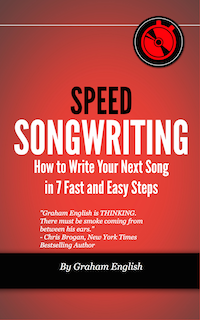
Taylor Swift isn’t just a household name—she’s a songwriting powerhouse.
Beyond her chart-topping albums, she’s constantly creating music, crafting lyrics, and penning melodies, even when she’s not actively releasing material. Her relentless approach to songwriting has yielded non-album hits, rejuvenated old tracks, and made her one of the most versatile and enduring artists in the industry.
But here’s the thing: Taylor’s consistency isn’t magic. It’s a habit—a commitment. And if you want to make serious progress as a songwriter, you must adopt this same relentless dedication to writing—no matter where you are in your journey.
Here’s why it works, how it’s transformed Taylor’s career, and how you can apply her approach to your own songwriting.
Writing Begets Breakthroughs
Think about this: Taylor Swift has written over 200 songs, yet only a fraction make it onto her albums. Songs like “This Is What You Came For,” a global hit she co-wrote for Calvin Harris and Rihanna, or Olivia Rodrigo’s “Deja Vu,” show that her creative output doesn’t stop at her own discography.
Every song she writes is a stepping stone. Some are polished into chart-toppers; others are stepping aside, making room for the next big idea. The takeaway? Quantity often leads to quality. You don’t stumble upon breakthrough moments by waiting for inspiration. You write your way to them.
Here’s what to do next: Write every day, even if it’s just a single lyric or melody. Treat songwriting like a muscle. The more you work it, the stronger it gets—and the more likely you will hit on something extraordinary.
The Power of Non-Album Hits
When Taylor Swift wrote “Safe & Sound” for The Hunger Games soundtrack, she wasn’t thinking about topping the pop charts. She created a haunting, cinematic piece that fit the film’s world. It went on to win a Grammy and became one of her most unique releases.
Non-album songs like this are often a sandbox for experimentation. Taylor can explore different styles, narratives, or collaborators without the pressure of fitting into a cohesive album. These creative detours not only keep her engaged but often result in standout tracks that expand her artistic range.
Try this: Write a song for a project outside your usual scope. It could be for a film, a friend’s celebration, or even an imaginary brief (think: “Write a song inspired by a rainy Sunday”). This mindset shift can spark ideas you wouldn’t normally consider.
Old Songs, New Life
Taylor’s “vault” releases, like the updated versions of her earlier work (Taylor’s Version), showcase the value of revisiting old material. These aren’t just nostalgia trips; they’re reinventions. Songs that might have been overlooked the first time around get a second life, reaching new audiences and resonating in fresh ways.
Every songwriter has drafts that didn’t quite land the first time. But those drafts aren’t failures—they’re opportunities. A lyric that felt clunky a year ago might spark something brilliant today. A melody you dismissed might become the perfect hook for a new project.
What you can do: Pull out your old notebooks or voice memos. Revisit a song you abandoned. Ask yourself: “What would Taylor do?” Maybe the melody needs a fresh arrangement, or the lyrics need a new perspective. Start there.
Writing as a Habit, Not an Event
Taylor’s consistency stems from treating songwriting as a daily practice, not a once-in-a-while event. Even during her busiest touring schedules, she jots down ideas, records snippets, and collaborates with co-writers like Jack Antonoff and Aaron Dessner.
This isn’t about perfection—it’s about showing up. Some days, you’ll write lyrics that feel groundbreaking. On other days, you’ll scribble lines you’ll never use. Both are valuable. The act of writing is what keeps your creativity flowing and prevents you from getting stuck.
Here are three steps to build the habit:
- Set a timer for 10 minutes each day and write whatever comes to mind. Don’t worry about quality—just get words down.
- Create a songwriting space. Whether it’s a corner of your bedroom or a dedicated studio, having a go-to spot makes it easier to sit down and create.
- Record every idea. Use your phone to capture melodies, hooks, or lyrical fragments. You never know what will become your next masterpiece.
Collaboration Fuels Creativity
Taylor Swift isn’t afraid to collaborate, and it’s paid off. Whether teaming up with pop juggernaut Max Martin for “1989” or indie legend Justin Vernon for Folklore, she’s embraced the fresh perspectives that co-writing brings.
Collaboration doesn’t just expand your skillset; it forces you to think outside your comfort zone. A co-writer might challenge you to simplify a chorus, rework a melody, or explore a genre you wouldn’t usually touch.
How to start: Find a songwriting partner. Reach out to a musician friend or connect with someone online. Come prepared with a rough idea—whether it’s a chord progression, lyric, or melody—and see where the process takes you.
Writing for the Long Game
Taylor’s willingness to keep writing—even when a song isn’t guaranteed a spot on the next album—is a reminder that success doesn’t happen overnight. She writes for the long game. Some songs find a home years after they were written, like “All Too Well,” which grew into a 10-minute opus beloved by fans.
Songwriting isn’t just about the final product—it’s about the journey. Every lyric, melody, or chord progression you create adds to your toolkit. Over time, this consistent practice leads to songs that feel inevitable, as if they’ve always existed.
What to remember: Be patient. Not every song you write will be “the one.” But every song brings you closer to it.
Embracing the Creative Process
At its core, Taylor’s approach to songwriting is about embracing the process. She writes because she loves it—not because every song needs to be a hit. This creative freedom allows her to take risks, experiment, and, ultimately, succeed.
Your journey doesn’t have to look exactly like hers, but the principles are universal. Show up. Write consistently. Embrace failure as part of the process. And trust that every song, good or bad, is a step forward.
Final Thoughts
Taylor Swift’s career isn’t built on luck. It’s built on a relentless commitment to her craft. She doesn’t wait for inspiration; she works for it. She doesn’t stop at albums; she explores every opportunity to write, experiment, and grow.
You can do the same. Pick up your pen. Hum that melody into your phone. Write the lyrics that scare you or the ones that make you laugh. The point is to keep going—because every song you write brings you closer to the breakthrough you’ve been waiting for.
So, what’s stopping you? Start writing. Today.

Enter your first name and email address below and click “GET ACCESS NOW!” to get the Speed Songwriting Cheat Sheet delivered to your inbox!
We guarantee 100% privacy. Your information will not be shared.

These two quotes are on the wall in my project studio:
“You can’t wait for inspiration. You have to go after it with a club.” – Jack London.
“Inspiration exists but it has to find you working.” – PabloPicasso.
I love both of those quotes! I think of the Picasso one all the time. Cheers!
Graham
received the cheat sheet.
Thank you
Great! You’re welcome. Happy songwriting!